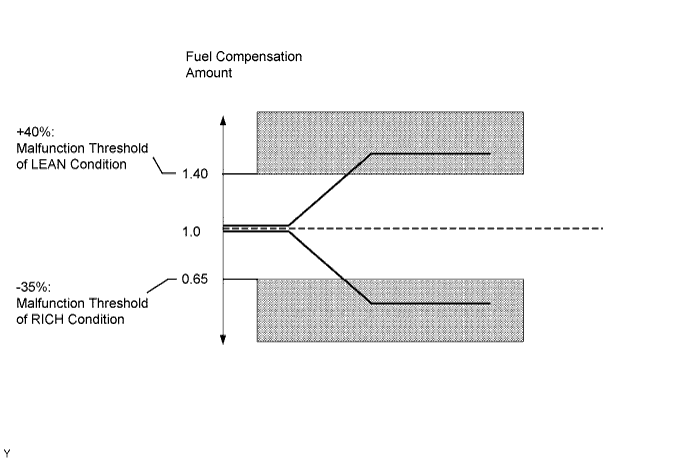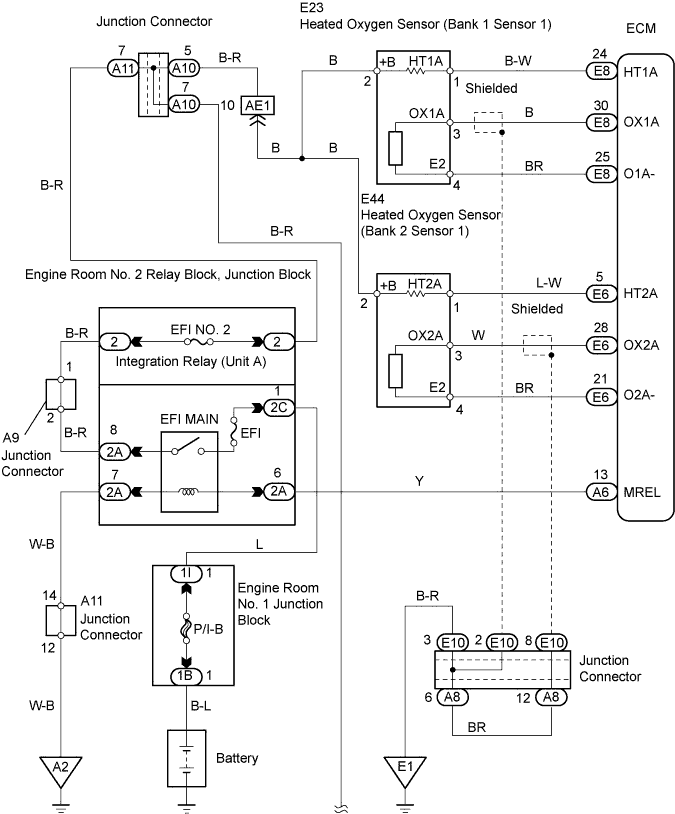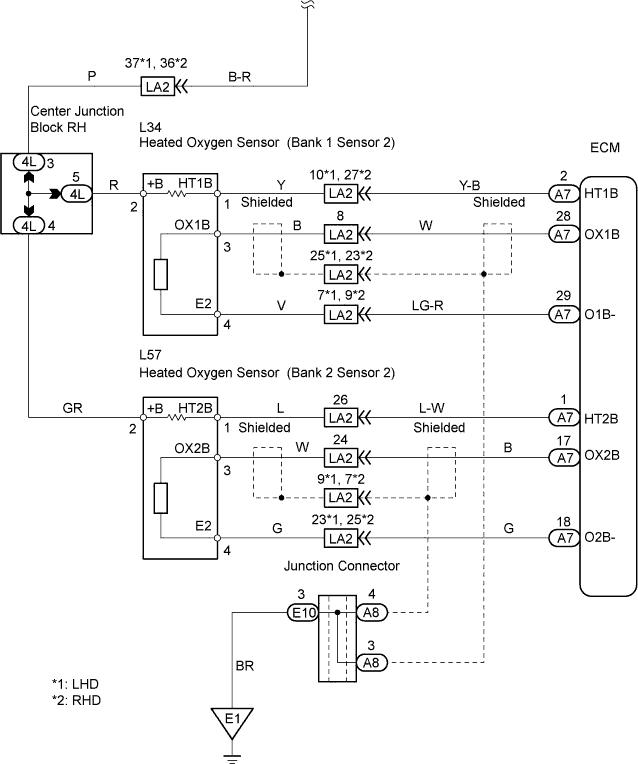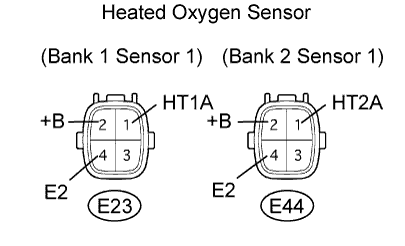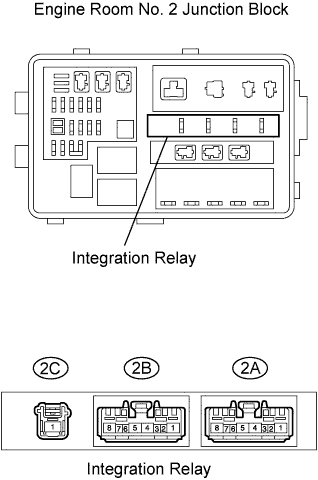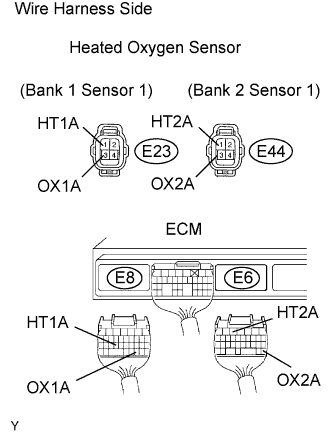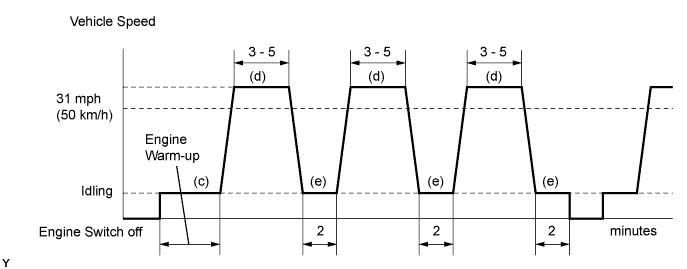Engine. Lexus Gs430, Gs300. Uzs190 Grs190
DESCRIPTION
MONITOR DESCRIPTION
WIRING DIAGRAM
INSPECTION PROCEDURE
CHECK OTHER DTC OUTPUT (IN ADDITION TO DTC P0171, P0172, P0174, P0175)
CHECK CONNECTION OF PCV HOSE
CHECK AIR INDUCTION SYSTEM
PERFORM ACTIVE TEST (CONTROL)
READ DATA LIST (COOLANT TEMP)
READ DATA LIST (MAF)
CHECK FUEL PRESSURE
CHECK FOR EXHAUST GAS LEAKAGE
CHECK FOR SPARK AND IGNITION
INSPECT FUEL INJECTOR
INSPECT HEATED OXYGEN SENSOR
INSPECT INTEGRATION RELAY (EFI MAIN)
CHECK WIRE HARNESS (HEATED OXYGEN SENSOR (SENSOR 1) - ECM)
REPLACE HEATED OXYGEN SENSOR
PERFORM CONFIRMATION DRIVING PATTERN
DTC P0171 System Too Lean (Bank 1) |
DTC P0172 System Too Rich (Bank 1) |
DTC P0174 System Too Lean (Bank 2) |
DTC P0175 System Too Rich (Bank 2) |
DESCRIPTION
The fuel trim is related to the feedback compensation value, not to the basic injection time. The fuel trim includes the short-term fuel trim and the long-term fuel trim.The short-term fuel trim is the short-term fuel compensation used to maintain the air-fuel ratio at the stoichiometric air-fuel ratio. The signal from the heated oxygen sensor indicates whether the air-fuel ratio is RICH or LEAN compared to the stoichiometric air-fuel ratio. This variance triggers a reduction in the fuel volume if the air-fuel ratio is RICH, and an increase in the fuel volume if it is LEAN.The short-term fuel trim varies from the central value due to individual engine differences, wear over time and changes in the operating environment. The long-term fuel trim, which controls overall fuel compensation, steadies long-term deviations of the short-term fuel trim from the central value.If both the short-term fuel trim and the long-term fuel trim are LEAN or RICH beyond a certain value, the ECM determines this as a malfunction, illuminates the MIL and sets a DTC.DTC No.
| DTC Detection Condition
| Trouble Area
|
P0171
P0174
| When air-fuel ratio feedback is stable after warming up engine, fuel trim is considerably in error on LEAN side (2 trip detection logic)
| - Air induction system
- Injector blockage
- MAF meter
- ECT sensor
- Fuel pressure
- Gas leakage in exhaust system
- Heated oxygen sensor (sensor 1)
- Heated oxygen sensor (sensor 1) heater
- EFI MAIN relay
- PCV valve and hose
- ECM
|
P0172
P0175
| When air-fuel ratio feedback is stable after warming up engine, fuel trim is considerably in error on RICH side (2 trip detection logic)
| - Injector leak or blockage
- MAF meter
- ECT sensor
- Ignition system
- Fuel pressure
- Gas leakage in exhaust system
- Heated oxygen sensor (sensor 1)
- Heated oxygen sensor (sensor 1) heater
- EFI MAIN relay
- ECM
|
- HINT:
- When DTC P0171 or P0174 is recorded, the actual air-fuel ratio is on the LEAN side. When DTC P0172 or P0175 is recorded, the actual air-fuel ratio is on the RICH side.
- If the vehicle runs out of fuel, the air-fuel ratio is LEAN and DTC P0171 or P0174 may be recorded. The MIL is then illuminated.
- If the total of the short-term fuel trim value and long-term fuel trim value is within the malfunction threshold (and ECT is more than 75°C (167°F)), the system is functioning normally.
MONITOR DESCRIPTION
Under closed-loop fuel control, fuel injection amounts that deviate from the ECM's estimated fuel amount will cause a change in the long-term fuel trim compensation value. Long-term fuel trim value is adjusted when persistent deviations in the short-term fuel trim's value are present. Also, the smoothed fuel trim learning value is adjusted when deviations from the ECM's simulated fuel injection value are present. The smoothed fuel trim learning value is a combination of smoothed short-term fuel trim (fuel feedback compensation value) and smoothed long-term fuel trim (learning value of the air-fuel ratio). When the smoothed fuel trim learning value exceeds the malfunction threshold, the ECM interprets this as a fault in the fuel system and sets a DTC.Example:The smoothed fuel trim learning value is above 40% or below -35%. The ECM interprets this as a fault in the fuel system.
WIRING DIAGRAM
INSPECTION PROCEDURE
- HINT:
- It is possible that the malfunctioning area can be found using the Active Test Control operation. The Active Test can determine if the heated oxygen sensor or other potential trouble areas are malfunctioning or not.
- The injection volume can be switched to -12.5% (decrease) or +25% (increase) by the Active Test.
- The Active Test procedure enables a technician to check and graph the output voltage of the heated oxygen sensors.
- Procedure:
- Connect the intelligent tester to the DLC3.
- Turn the engine switch on (IG).
- Warm up the engine by running the engine at 2,500 rpm for approximately 90 seconds.
- Enter the following menus: Powertrain / Engine / Active Test / Control the Injection Volume.
- Perform the Active Test while the engine is idling.
- Standard:
- The heated oxygen sensor reacts in accordance with the increase and decrease of injection volume:
+25% → RICH output: More than 0.55 V
-12.5% → LEAN output: Less than 0.4 V
- NOTICE:
- The heated oxygen sensor (sensor 1) output has a few seconds of delay and the heated oxygen sensor (sensor 2) output has a maximum of 20 seconds of delay.
- If the vehicle is short on fuel, the air-fuel ratio becomes LEAN and the DTCs will be recorded.
Case
| Heated Oxygen Sensor (sensor 1) Voltage
| Heated Oxygen Sensor (sensor 2) Voltage
| Main Suspected Trouble Area
|
1
| Injection Volume
+25%
-12.5%
| 
| Injection Volume
+25%
-12.5%
| 
| -
|
Heated Oxygen Sensor Voltage
0.55 V or more
Below 0.4 V
| 
| Heated Oxygen Sensor Voltage
0.5 V or more
Below 0.4 V
| 
|
2
| Injection Volume
+25%
-12.5%
| 
| Injection Volume
+25%
-12.5%
| 
| Heated oxygen sensor (sensor 1)
Heated oxygen sensor heater (sensor 1)
|
Heated Oxygen Sensor Voltage
Almost
no reaction
| 
| Heated Oxygen Sensor Voltage
0.5 V or more
Below 0.4 V
| 
|
3
| Injection Volume
+25%
-12.5%
| 
| Injection Volume
+25%
-12.5%
| 
| Heated oxygen sensor (sensor 2)
Heated oxygen sensor heater (sensor 2)
|
Heated Oxygen Sensor Voltage
0.55 V or more
Below 0.4 V
| 
| Heated Oxygen Sensor Voltage
Almost
no reaction
| 
|
4
| Injection volume
+25%
-12.5%
| 
| Injection Volume
+25%
-12.5%
| 
| Injector fuel pressure, Exhaust gas leak, etc.
(air-fuel ratio is extremely LEAN or RICH)
|
Heated Oxygen Sensor Voltage
Almost
no reaction
| 
| Heated Oxygen Sensor Voltage
Almost
no reaction
| 
|
- HINT:
- Read freeze frame data using the intelligent tester. Freeze frame data records the engine conditions when a malfunction is detected. When troubleshooting, freeze frame data can help determine if the vehicle was running or stopped, if the engine was warmed up or not, if the air-fuel ratio was LEAN or RICH, and other data from the time the malfunction occurred.
- A high heated oxygen sensor (sensor 1) voltage (0.55 V or more) indicates a RICH air-fuel ratio.
- A low heated oxygen sensor (sensor 1) voltage (0.4 V or less) indicates a LEAN air-fuel ratio.
| 1.CHECK OTHER DTC OUTPUT (IN ADDITION TO DTC P0171, P0172, P0174, P0175) |
Connect the intelligent tester to the DLC3.
Turn the engine switch on (IG) and turn the tester ON.
Enter the following menus: Powertrain / Engine / DTC.
Read the DTCs.
- Result:
Display (DTC output)
| Proceed to
|
P0171, P0172, P0174 or P0175
| A
|
P0171, P0172, P0174 or P0175 and other DTCs
| B
|
| 2.CHECK CONNECTION OF PCV HOSE |
- OK:
- PCV hose is connected correctly and is not damaged.
| | REPAIR OR REPLACE PCV HOSE |
|
|
| 3.CHECK AIR INDUCTION SYSTEM |
Check the air induction system for vacuum leaks.
| | REPAIR OR REPLACE AIR INDUCTION SYSTEM |
|
|
| 4.PERFORM ACTIVE TEST (CONTROL) |
Perform the Active Test Control with the intelligent tester and check the heated oxygen sensor status.
- Standard voltage:
- Heated oxygen sensor reacts in accordance with the increase and decrease of injection volume:
+25% → RICH output: More than 0.55 V
-12.5% → LEAN output: Less than 0.4 V
Related DTCs
| Heated Oxygen Sensor Status
| Condition and Heated Oxygen Sensor Condition
| Misfire
| Main Suspected Trouble Area
| Go to Step
|
B1 S1
| B1 S2
| B2 S1
| B2 S2
|
N/A
| L/R
| L/R
| L/R
| L/R
| Normal
| None
| None
| N/A
|
P0171
P0174
| L
| L
| L
| L
| Actual is LEAN at all cylinders
| May occur
| PCV hose, air induction system, fuel pressure, MAF or ECT
| A
|
P0172
P0175
| R
| R
| R
| R
| Actual is RICH at all cylinders
| None
| Fuel pressure, MAF or ECT
|
P0171
| L
| L
| L/R
| L/R
| Actual is LEAN at bank 1
| May occur
| Spark plug, ignition system, injector or exhaust gas leak
| B
|
P0174
| L/R
| L/R
| L
| L
| Actual is LEAN at bank 2
|
P0172
| R
| R
| L/R
| L/R
| Actual is RICH at bank 1
| None
| Spark plug, ignition system or injector
| C
|
P0175
| L/R
| L/R
| R
| R
| Actual is RICH at bank 2
|
P0171
| L
| R
| L/R
| L/R
| Heated oxygen sensor (bank 1 sensor 1) malfunction
| None
| Heated oxygen sensor (bank 1 sensor 1)
| D
|
P0174
| L/R
| L/R
| L
| R
| Heated oxygen sensor (bank 2 sensor 1) malfunction
| None
| Heated oxygen sensor (bank 2 sensor 1)
|
P0172
| R
| L
| L/R
| L/R
| Heated oxygen sensor (bank 1 sensor 1) malfunction
| None
| Heated oxygen sensor (bank 1 sensor 1)
|
P0175
| L/R
| L/R
| R
| L
| Heated oxygen sensor (bank 2 sensor 1) malfunction
| None
| Heated oxygen sensor (bank 2 sensor 1)
|
- HINT:
- L: During control of the Active Test, the output voltage of the heated oxygen sensor almost always indicates 0.4 V or less (LEAN).
- R: During control of the Active Test, the output voltage of the heated oxygen sensor almost always indicates 0.5 V or more (RICH).
| 5.READ DATA LIST (COOLANT TEMP) |
Connect the intelligent tester to the DLC3.
Enter the following menus: Powertrain / Engine / Data List / Primary / Coolant Temp.
Read the Coolant Temp value when the engine is cold and warmed-up.
- Standard:
- ECT when the engine is cold: Same as ambient temperature
ECT when the engine is warmed up: 75 to 95°C (167 to 203°F)
| | REPLACE ENGINE COOLANT TEMPERATURE SENSOR |
|
|
Enter the following menus: Powertrain / Engine / Data List / Primary / Coolant Temp and MAF.
Allow the engine to idle until the ECT reaches 75°C (167°F).
Read the MAF value at idle rpm and 3,000 rpm.
- Standard:
- MAF at idle rpm: 3 to 6 g/s (shift lever is in N position and A/C is OFF)
MAF at 3,000 rpm: 11 to 23 g/s (shift lever is in N position and A/C is OFF)
| | REPLACE MASS AIR FLOW METER |
|
|
Check the fuel pressure (Click here).
| | REPAIR OR REPLACE FUEL SYSTEM |
|
|
| 8.CHECK FOR EXHAUST GAS LEAKAGE |
- OK:
- No gas leakage.
| | REPAIR OR REPLACE EXHAUST SYSTEM |
|
|
| 9.CHECK FOR SPARK AND IGNITION |
- HINT:
- If the spark plugs or ignition system malfunction, engine misfire may occur. The misfire counter can be read with the intelligent tester. Enter the following menus: Powertrain / Engine / Data List / Primary / Cylinder #1 (to #8) Misfire Rate.
| | REPAIR OR REPLACE IGNITION SYSTEM |
|
|
- HINT:
- If the injectors are malfunctioning, engine misfire may occur. The misfire counter can be read with the intelligent tester. Enter the following menus: Powertrain / Engine / Data List / Primary.
| 11.INSPECT HEATED OXYGEN SENSOR |
Disconnect the E23 and E44 sensor connectors.
Measure the resistance of the sensor.
- Standard resistance:
Tester Connection
| Specified Condition
|
E23-1 (HT1A) - E23-2 (+B)
| 11 to 16 Ω
|
E44-1 (HT2A) - E44-2 (+B)
| 11 to 16 Ω
|
E23-1 (HT1A) - E23-4 (E2)
| 10 kΩ or higher
|
E44-1 (HT2A) - E44-4 (E2)
| 10 kΩ or higher
|
| | REPLACE HEATED OXYGEN SENSOR |
|
|
| 12.INSPECT INTEGRATION RELAY (EFI MAIN) |
Remove the integration relay from the engine room No. 2 junction block.
Measure the resistance of the EFI MAIN relay.
- Standard resistance:
Terminal Connections
| Specified Condition
|
2A-8 - 2C-1
| 10 kΩ or higher
|
2A-8 - 2C-1
| Below 1 Ω
(when battery voltage is applied to terminals 2A-6 and 2A-7)
|
| | REPLACE INTEGRATION RELAY |
|
|
| 13.CHECK WIRE HARNESS (HEATED OXYGEN SENSOR (SENSOR 1) - ECM) |
Disconnect the E23 and E44 sensor connectors.
Disconnect the E6 and E8 ECM connectors.
Measure the resistance of the wire harness side connectors.
- Standard resistance:
Tester Connection
| Specified Condition
|
E23-1 (HT1A) - E8-24 (HT1A)
| Below 1 Ω
|
E23-3 (OX1A) - E8-30 (OX1A)
| Below 1 Ω
|
E44-1 (HT2A) - E6-5 (HT2A)
| Below 1 Ω
|
E44-3 (OX2A) - E6-28 (OX2A)
| Below 1 Ω
|
E23-1 (HT1A) or E8-24 (HT1A) - Body ground
| 10 kΩ or higher
|
E23-3 (OX1A) or E8-30 (OX1A) - Body ground
| 10 kΩ or higher
|
E44-1 (HT2A) or E6-5 (HT2A) - Body ground
| 10 kΩ or higher
|
E44-3 (OX2A) or E6-28 (OX2A) - Body ground
| 10 kΩ or higher
|
| | REPAIR OR REPLACE HARNESS AND CONNECTOR |
|
|
| 14.REPLACE HEATED OXYGEN SENSOR |
| 15.PERFORM CONFIRMATION DRIVING PATTERN |
(a) Connect the intelligent tester to the DLC3.(b) Switch from normal mode to check mode. (c) Warm up the engine until the ECT reaches 75°C (167°F).(d) Drive the vehicle at 50 km/h (31 mph) or more for 3 to 5 minutes.(e) Allow the engine to idle for 2 minutes.(f) Perform steps "d" and "e" at least 3 times.If a malfunction exists, the MIL is illuminated during step "f".- NOTICE:
- If the conditions in this test are not strictly followed, detection of a malfunction will not occur. If you do not have the intelligent tester, turn the engine switch off after performing steps "c" to "f", and then perform steps "c" to "f" again.
(g) Confirm that no DTC is output.
